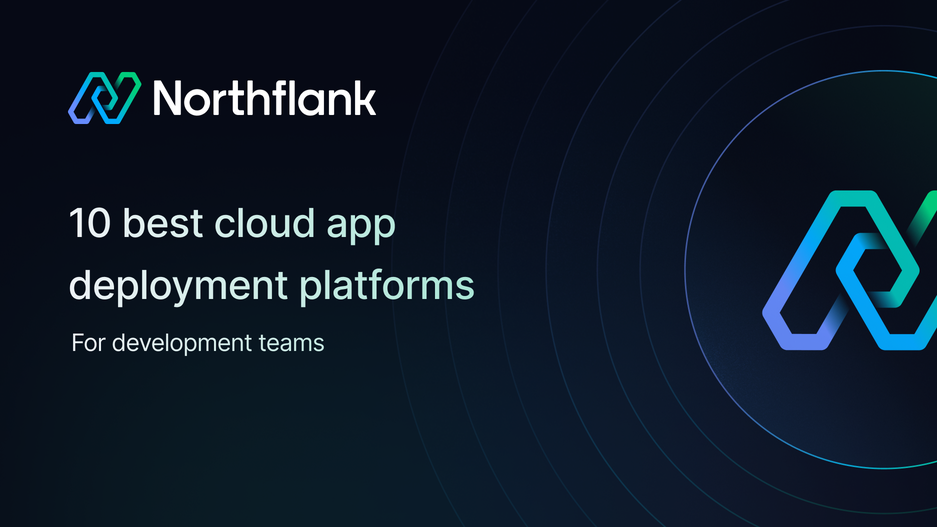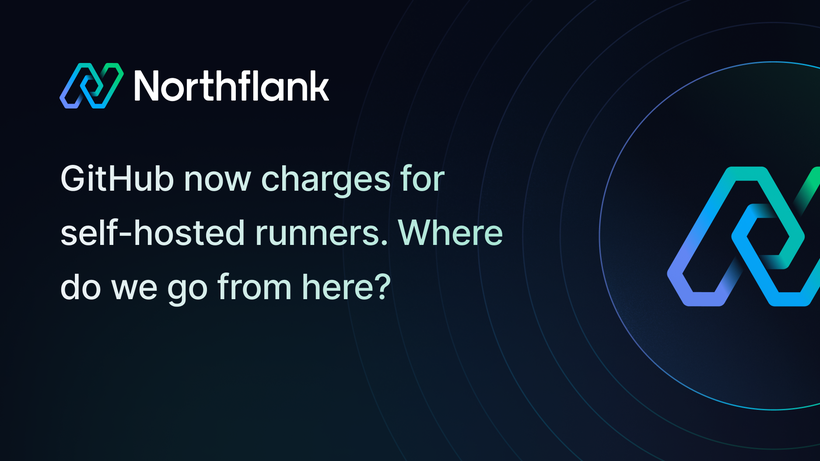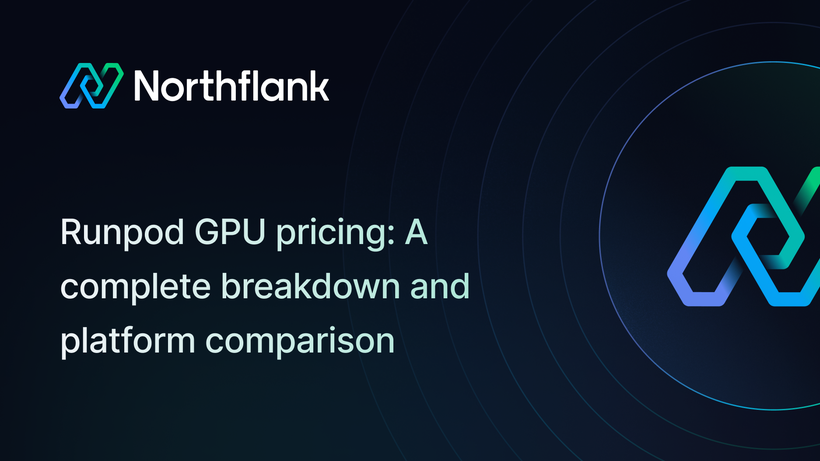

10 best cloud app deployment platforms for development teams in 2025
I remember the days when deploying an application meant manually configuring servers, resolving dependency conflicts, and crossing my fingers, hoping everything would work in production. Well, those days are long gone.
We now have modern cloud app deployment platforms that have turned what used to be a complex, error-prone process into a simplified workflow.
Now, a development team can build, ship, and scale applications with a few clicks.
And the best part is that these cloud app deployment platforms, like Northflank, do way more than simple hosting. They’re providing you with:
- integrated CI/CD pipelines
- automatic scaling
- built-in security features
- database management
- monitoring tools
- … and so on
We’re now in a time where developers can finally focus on writing code rather than managing infrastructure.
So, I’ll review the top 10 cloud app deployment platforms to help you determine where they best fit for your projects and teams’ needs.
I’ve put together this side-by-side comparison to help you quickly identify which platform matches your needs and budget.
| Platform | Best For | Free Tier | Starting Price | Key Strengths |
|---|---|---|---|---|
| Northflank | All-in-one deployment with enterprise features | Yes (Developer Sandbox) | CPU: $2.70/month ($0.0038/hr), GPU: $1.42/hr (A100), $2.74/hr (H100) | Enterprise-grade security, multi-cloud, bring your own cloud option (deploy in your AWS/GCP/Azure), GPU orchestration, autoscaling |
| Heroku | Prototyping and simple deployment | No (discontinued 2022) | $5/month (Eco plan - 1,000 hours shared) | Simple deployment, extensive add-ons, minimal configuration |
| AWS App Runner | AWS ecosystem integration | 12 months free tier | $0.064/vCPU hour + $0.007/GB hour | AWS integration, automatic scaling, containerized apps |
| Google Cloud Run | Serverless container deployment | Yes (2 million requests/month) | $0.48/million requests | Pay-per-use, serverless, automatic scaling, multi-language support |
| Render | Full-stack applications and databases | Yes (static sites, limited services) | $7/month (Starter web service) | Modern Heroku alternative, background workers, PostgreSQL included |
| Vercel | Frontend and Jamstack applications | Yes (Hobby plan) | $20/month per user (Pro plan) | Global CDN, Next.js optimization, instant deployments, edge functions |
| Railway | Backend services with databases | Yes ($5 credit one-time) | $5/month (Hobby plan includes $5 usage) | Developer-friendly, database support, usage-based pricing |
| Fly.io | Edge deployment and global distribution | Yes ($5 credit monthly) | Usage-based from ~$1.94/month | Edge computing, global distribution, low latency, Docker-native |
| Azure App Service | Microsoft stack integration | 12 months free tier | $13.87/month (Basic B1) | Azure integration, .NET support, enterprise features |
| Netlify | Static sites and Jamstack | Yes (100GB bandwidth/month) | $19/month (Pro plan) | Build automation, form handling, serverless functions, Git workflow |
A cloud app deployment platform is a service that handles everything needed to get your applications from your local development environment to live production systems without the manual server setup, dependency management, and configuration issues that developers used to face.
In place of having to manually set up your servers and manage them yourself, configure your databases, handle updates yourself, manage your SSL certificates, and stress about scaling…these platforms help handle all the infrastructure complexity for you.
In most cases, all you have to do is connect your code repository, and the platform takes care of building, deploying, and running your application in the cloud.
And cloud app deployment platforms like Northflank provide you with:
- integrated CI/CD pipelines
- automatic scaling
- built-in security features
- database management
- monitoring tools
- global content delivery networks
Let's go on to discuss what you should look out for in cloud app deployment platforms before you make your choice.
-
Performance and latency optimization:
Look for platforms with global CDNs, edge computing, and optimized routing for fast response times regardless of your users’ location.
-
Horizontal scaling and multi-region support:
Choose platforms that auto-scale server instances, distribute apps across regions, and provide load balancing.
-
Security and isolation capabilities:
Look for container isolation, network security and automated security updates.
-
Multi-cloud and BYOC (bring your own cloud) support:
Prioritize platforms that let you deploy across different cloud providers or use your own cloud accounts.
-
GPU and AI workload compatibility:
Choose platforms that provide dedicated GPU instances, support for AI frameworks, and machine learning workload handling.
-
Developer experience:
Focus on platforms with comprehensive APIs, integrated CI/CD pipelines, and easy integration with GitHub or GitLab.
-
Database and service orchestration:
Select platforms that handle your entire stack: databases, Redis caches, background workers, and scheduled jobs.
-
Monitoring and observability tools:
Choose platforms that provide real-time metrics, centralized logging, error tracking, and alerting systems.
Let’s review each platform to see their main features, pricing model, best use cases, and how they handle deployment workflows.
We'll also look at their strengths and limitations to help you understand which platform best fits your specific project needs and team requirements.
If you want an all-in-one deployment platform that handles everything from simple web apps to complex AI workloads, Northflank delivers enterprise-grade capabilities with a developer-friendly interface.

Main features
- MicroVM isolation for better security
- Multi-cloud deployment with bring your own cloud option
- GPU access for AI workloads (H100 at $2.74/hour, B200 at $5.87/hour)
- Full-stack support: databases, jobs, services, and networking in one platform
- Enterprise features: RBAC, audit logs, SSO, private networking
- Free tier: Generous limits for testing and small projects
- CPU instances: Starting at $2.70/month ($0.0038/hr) for small workloads, scaling to production-grade dedicated instances
- GPU support: NVIDIA A100 40GB at $1.42/hr, A100 80GB at $1.76/hr, H100 at $2.74/hr, up to B200 at $5.87/hr
- Enterprise BYOC: Flat fees for clusters, vCPU, and memory on your infrastructure, no markup on your cloud costs
- Pricing calculator available to estimate costs before you start
- Fully self-serve platform, get started immediately without sales calls
- No hidden fees, egress charges, or surprise billing complexity like SageMaker
Best use cases
Production applications needing enterprise-grade security, AI/ML workloads, complex multi-service architectures, or multi-cloud flexibility.
Pros and cons
Pros: All-in-one platform, affordable pricing, enterprise-grade security built in, no vendor lock-in, supports both AI and web applications
Cons: May be feature-rich for simple sites, learning curve for new users, smaller community
If you want to get your application online quickly without dealing with server configuration, Heroku provides a straightforward platform that handles the technical complexity for you.

Main features
- Git-based deployment: Push code to deploy automatically
- Buildpack system supporting Node.js, Python, Ruby, Java, PHP, Go
- Add-on marketplace with databases, monitoring, and email services
- Dyno-based scaling with horizontal and vertical options
- Pipeline management with staging, production, and review apps
Pricing and plans
- Eco Plan: $5/month for 1,000 shared dyno hours (sleeps after 30 minutes)
- Basic Plan: $7/month per dyno for dedicated resources
- Standard Plan: $25-50/month per dyno with scaling features
- Add-ons: Separate pricing for PostgreSQL ($9/month+), Redis ($15/month+)
Best use cases
Web applications, APIs, prototypes, startups needing quick deployment, and teams preferring to focus on code rather than infrastructure management.
Pros and cons
Pros: Simple deployment process, extensive add-on ecosystem, automatic SSL, built-in CI/CD, large community support
Cons: Expensive at scale, limited infrastructure control, dyno sleep on lower plans, potential vendor lock-in with proprietary add-ons
Learn more about Heroku:
- How to migrate from Heroku: A step-by-step guide
- Top Heroku alternatives in 2025
- Heroku Enterprise: capabilities, limitations, and alternatives
If you're already using AWS services and want containerized application deployment without managing infrastructure, App Runner provides automatic scaling and direct integration with your existing AWS setup.

Main features
- Source-based deployment from GitHub or container registries
- Automatic scaling from zero to high traffic with pay-per-use
- Built-in load balancing and health checks
- VPC connectivity for private AWS resources
- Integration with AWS services like RDS, ElastiCache, and CloudWatch
Pricing and plans
- Compute: $0.064 per vCPU hour, $0.007 per GB memory hour
- Requests: $0.20 per million requests
- Build: $0.005 per build minute
- Free tier: 2,000 build minutes, 200,000 requests monthly for 2 months
Best use cases
Web applications, APIs, microservices for teams already using AWS infrastructure, applications needing VPC access to private AWS resources.
Pros and cons
Pros: Deep AWS integration, automatic scaling, no infrastructure management, pay-per-use pricing, built-in security features
Cons: Limited to AWS ecosystem, fewer customization options than ECS/EKS, regional availability restrictions
Check out 9 best AWS App Runner alternatives for scalable container apps
If you want serverless container deployment with automatic scaling and pay-only-for-requests pricing, Cloud Run handles traffic spikes efficiently without server management.

Main features
- Deploy any containerized application serverlessly
- Automatic scaling from zero to thousands of instances
- Built-in traffic splitting for gradual rollouts
- Custom domains with managed SSL certificates
- Integration with Google Cloud services and APIs
Pricing and plans
- Requests: $0.40 per million requests
- CPU: $0.048 per vCPU hour (only while processing)
- Memory: $0.0053 per GB hour
- Free tier: 2 million requests, 400,000 GB-seconds monthly
Best use cases
APIs with variable traffic, event-driven applications, microservices, applications with unpredictable or spiky usage patterns.
Pros and cons
Pros: True serverless pricing, fast cold starts, automatic HTTPS, global deployment, integrates with Google Cloud ecosystem
Cons: Limited to stateless applications, cold start latency, Google Cloud vendor lock-in for advanced features
Learn more about Google Cloud Run:
- Best Google Cloud Run alternatives in 2025
- App Engine vs. Cloud Run: A real-world engineering comparison
If you're using .NET, Microsoft development tools, or need enterprise-grade features with Azure integration, App Service provides managed hosting with extensive Microsoft ecosystem support.

Main features
- Support for .NET, Node.js, Python, Java, PHP applications
- Built-in DevOps with Azure DevOps and GitHub integration
- Auto-scaling based on metrics or schedule
- Staging slots for testing and gradual deployments
- Enterprise features: AD authentication, hybrid connections, VNet integration
Pricing and plans
- Free tier: 1 GB storage, custom domains not supported
- Basic: $13.87/month (B1 plan) with custom domains and SSL
- Standard: $73.00/month (S1) with auto-scaling and staging slots
- Premium: $292.00/month (P1V3) with advanced scaling and VNet integration
Best use cases
.NET applications, enterprise web apps, applications requiring Active Directory integration, hybrid cloud scenarios.
Pros and cons
Pros: Strong .NET support, enterprise security features, Azure ecosystem integration, multiple deployment options, staging environments
Cons: Can be expensive for simple applications, complex pricing tiers, primarily optimized for Microsoft technologies
Learn more about Azure App Service:
- Top 10 Microsoft Azure alternatives in 2025: Best cloud platforms for your business
- Azure migration strategy for 2025: How to get it right
If you want a modern alternative to Heroku with better performance and pricing, Render provides web services, databases, and background workers in one platform.

Main features
- Web services with automatic SSL and custom domains
- Managed PostgreSQL databases with point-in-time recovery
- Background workers and cron jobs as first-class services
- Static site hosting with global CDN
- Private services for internal communication
Pricing and plans
- Free tier: Static sites, web services (with limitations), PostgreSQL database
- Web services: $7/month (Starter), $25/month (Standard), $85/month (Pro)
- PostgreSQL: $7/month (Starter), $20/month (Standard)
- Background workers: Same pricing as web services
Best use cases
Full-stack web applications, applications needing background processing, teams wanting Heroku-like experience with better pricing.
Pros and cons
Pros: Built-in database support, background workers included, competitive pricing, automatic deployments from Git, free tier for testing
Cons: Smaller ecosystem than established platforms, fewer third-party integrations, limited geographic regions
Learn more about Render:
- 7 Best Render alternatives for simple app hosting in 2025
- Render vs Vercel (2025): Which platform suits your app architecture better?
- Railway vs Render (2025): Which cloud platform fits your workflow better
- Fly.io vs Render: How they handle jobs, scaling, and production workloads in 2025
- Render vs Heroku: Which platform-as-a-service is right for you in 2025?
If you want simple deployment with usage-based pricing and don't want to manage credits or complex billing, Railway provides straightforward hosting for applications and databases.

Main features
- One-click database deployment (PostgreSQL, MySQL, MongoDB, Redis)
- Git-based deployments with automatic builds
- Environment variables and secrets management
- Private networking between services
- Usage-based billing with transparent pricing
Pricing and plans
- Free trial: $5 credit (one-time)
- Hobby: $5/month includes $5 usage credit
- Pro: $20/month per seat includes priority support
- Usage: CPU, memory, network, and storage billed separately
Best use cases
Backend APIs, database-heavy applications, side projects, applications with predictable resource usage.
Pros and cons
Pros: Simple pricing model, database management, transparent usage tracking, developer-friendly interface, no complex configuration
Cons: Credit-based system can cause unexpected shutdowns, limited advanced features, smaller community and ecosystem
Learn more about Railway: 6 best Railway alternatives in 2025: Pricing, flexibility & BYOC
If your users are globally distributed and you need low-latency access, Fly.io runs your applications close to users worldwide with edge computing capabilities.

Main features
- Global deployment across 30+ regions
- Anycast networking for automatic traffic routing
- Persistent volumes that can move with your applications
- Direct VM access for custom configurations
- Built-in service discovery and load balancing
Pricing and plans
- Free tier: 3 shared-cpu VMs, 256MB RAM each
- Usage-based: $0.0000016 per second per 256MB RAM
- Persistent storage: $0.15/GB per month
- Outbound data: $0.02/GB
Best use cases
Applications serving global audiences, real-time applications, edge computing workloads, applications requiring low latency.
Pros and cons
Pros: Global edge deployment, low latency, flexible VM configurations, competitive pricing for global reach
Cons: Command-line heavy workflow, learning curve for edge concepts, limited managed services compared to traditional clouds
Learn more about Fly.io:
- Top 6 Fly.io alternatives in 2025
- Fly.io vs Render: How they handle jobs, scaling, and production workloads in 2025
If you're building React, Next.js, or other frontend applications and want automatic deployments with global CDN, Vercel optimizes for frontend developer experience.

Main features
- Optimized for Next.js, React, Vue, and other frontend frameworks
- Automatic deployments with Git integration
- Global CDN with edge functions
- Preview deployments for every pull request
- Built-in analytics and performance monitoring
Pricing and plans
- Hobby: Free with usage limits
- Pro: $20/month per user with increased limits
- Enterprise: Custom pricing with advanced features
- Usage-based: Function invocations, bandwidth, build minutes
Best use cases
React/Next.js applications, static sites, Jamstack applications, frontend-focused development teams.
Pros and cons
Pros: Optimized for frontend frameworks, automatic deployments, global CDN, preview environments, strong developer experience
Cons: Primarily frontend-focused, can become expensive with high usage, complex pricing structure for larger applications
Learn more about Vercel:
- Top Vercel Sandbox alternatives for secure AI code execution and sandbox environments
- Best Vercel Alternatives for Scalable Deployments
- Vercel vs Netlify: Choosing the right one in 2025 (and what comes next)
- Vercel vs Heroku: Which platform fits your workflow best?
- Render vs Vercel (2025): Which platform suits your app architecture better?
If you're building static sites or Jamstack applications with build processes and form handling, Netlify provides comprehensive tooling for modern web development workflows.

Main features
- Static site hosting with global CDN
- Build automation with various static site generators
- Form handling without backend code
- Identity and authentication management
- Edge functions for serverless logic
Pricing and plans
- Free: 100GB bandwidth, 300 build minutes monthly
- Pro: $19/month with increased limits and analytics
- Business: $99/month with role-based access and advanced features
- Enterprise: Custom pricing
Best use cases
Static websites, documentation sites, marketing sites, Jamstack applications with forms and authentication needs.
Pros and cons
Pros: Static site optimization, built-in form handling, comprehensive build system, branch deployments, strong community
Cons: Limited to static/Jamstack applications, serverless functions have execution limits, can be expensive for high-traffic sites
Learn more about Netlify: 7 Netlify alternatives in 2025: Where to go when your app grows up
Choosing the right deployment platform depends on matching your specific requirements with each platform's strengths. Here's a practical framework to guide your decision.
-
Assess your application requirements:
Start by identifying what you're building - a simple static site, a complex web application, or an AI-powered service. Consider whether you need databases, background workers, scheduled jobs, or real-time features. Your technical stack (React, Python, .NET) will also influence which platforms offer the best support.
-
Consider your team size and expertise:
Small teams often benefit from platforms like Railway or Render that minimize configuration, while larger teams might prefer comprehensive solutions like Northflank or AWS App Runner. Consider your team's DevOps experience - if infrastructure management isn't your strength, managed platforms will be more valuable than DIY solutions.
-
Evaluate scalability needs:
Think about your current traffic and growth projections. If you expect variable or unpredictable traffic, serverless options like Google Cloud Run or Vercel make sense. For steady growth, platforms with clear scaling paths like Northflank or Azure App Service provide better cost control.
-
Security and compliance requirements:
If you handle sensitive data or operate in regulated industries, prioritize platforms with built-in compliance features. Look for container isolation, and audit logging capabilities.
-
Budget considerations:
Compare total cost of ownership, not just base pricing. Factor in compute costs, data transfer, add-on services, and potential scaling expenses. Usage-based pricing can be cost-effective for variable workloads, while fixed pricing offers predictability.
-
Integration requirements
Consider your existing tools and services. If you're already using AWS, App Runner might make sense. For Microsoft shops, Azure App Service integrates naturally. For multi-cloud flexibility, platforms like Northflank offer bring-your-own-cloud options.
Decision checklist
- Does the platform support your programming language and framework?
- Can it handle your expected traffic and scaling requirements?
- Does pricing align with your budget and usage patterns?
- Are required compliance and security features available?
- How well does it integrate with your existing development workflow?
- What level of support and documentation is provided?
Get started with a platform that handles everything from simple apps to complex AI workloads. Try Northflank's free Developer Sandbox and see how an all-in-one deployment solution can simplify your development workflow.


